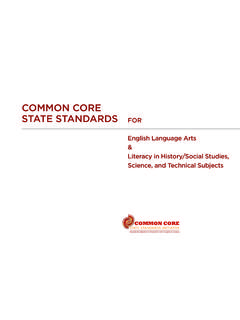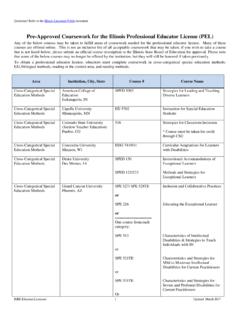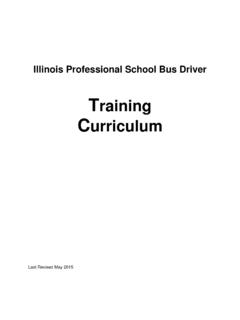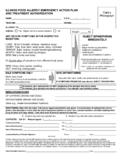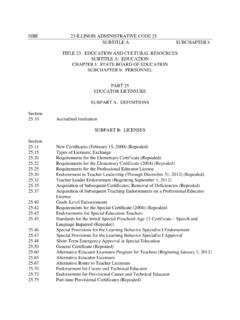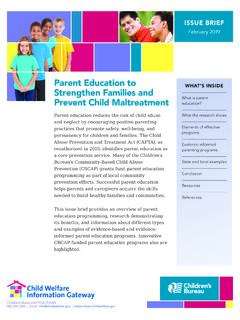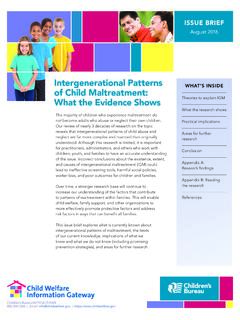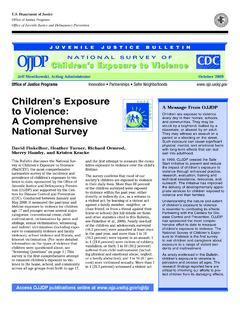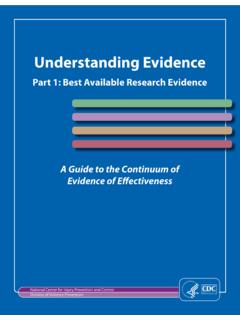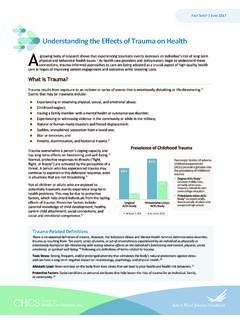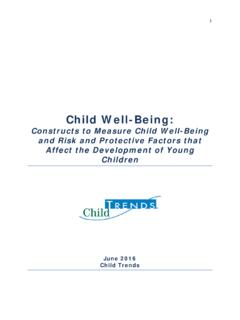Transcription of Understanding Traumatic Stress in Adolescents Fact Sheet
1 Linking Trauma & Substance Abuse: Understanding Traumatic StressII. 11 This project was funded by the Substance Abuse and Mental Health Services Administration (SAMHSA), Department of Health and Human Services (HHS). The views, policies, and opinions expressed are those of the authors and do not necessarily reflect those of SAMHSA or Traumatic STRESSIn AdolescentsYouth services providers should always be aware of the links between adolescent Traumatic Stress and substance abuse problems. Carefully assessing for trauma exposure and its possible effects on youth functioning should be an integral part of the services provided by agencies and individuals working with Adolescents , particularly in substance abuse treatment programs where youth trauma exposure is very common. Even with all the challenges to delivering integrated services, better care can be achieved through increased communication and coordination among mental health providers and substance abuse providers and through increased awareness about the needs of youth with co-occurring disorders across fields.
2 In people suffering from Traumatic Stress and/or substance abuse, particular triggers contribute to dysregulated emotions or behaviors. In traumatized youth, reminders of past traumas or losses can trigger a range of emotional and behavioral problems including physiological hyperarousal, hypervigilance, avoidance, numbing, angry outbursts, and substance craving. When substance abuse providers become more trauma-informed, and mental health providers become more substance abuse informed, they become better able to reinforce youths practice and acquisition of more adaptive coping skills to manage distress in the context of either type of problem. Improvements in the ability to manage Traumatic Stress symptoms, for example, reduce the chances of relapse after substance abuse treatment is in treatment for substance abuse will greatly benefit from receiving care from clinical staff who are also knowledgeable about trauma exposure, trauma-informed treatment, the complex relationship between Traumatic Stress and substance abuse, and the potential impact of both problems on treatment the information in this fact Sheet providers can broaden their Understanding of adolescent Traumatic Stress and the typical problems that follow trauma exposure in adolescence.
3 A developmental and contextual perspective on youth trauma is presented, with special attention paid to the links between trauma exposure, Traumatic Stress , and the development of substance abuse problems. Fact Sheet Series for PROVIDERS treating teens with EMOTIONAL & SUBSTANCE USE PROBLEMSNCTSNThe National ChildTraumatic Stress Network 2 Linking Trauma & Substance Abuse: Understanding Traumatic StressII. 12 Maria s Story*Maria, a 14-year-old girl, has been physically and sexually abused by her 22-year-old stepbrother for five years. The first incident of abuse happened when she and her mother moved in with the new stepfamily, after having been evicted from their old apartment. In addition, Maria has seen her stepfather severely hit her mother several times, and is now constantly worried about her mother s safety.
4 Maria has become withdrawn at school and no longer participates in activities she once enjoyed. Once very popular with her peers, she has isolated herself from many of her friends and spends most of her time alone. She fears that someone will find out about the abuse and that she will be taken away from her mother. The only person that Maria has been spending a lot of time with is her cousin who lives in the neighborhood. Lately, they have been skipping school and experimenting with marijuana and alcohol. Maria used to be an honor roll student, but her grades have been spiraling downward. Her favorite teacher, Ms. Jacobs, is extremely concerned and has been trying to get Maria to talk to her about what is causing such a change. * Maria s story was created by the authors as a composite representation of stories heard from real teenage clients struggling with these issues and provides examples of the challenges that clinicians face in providing care for youth with trauma and substance abuse problems.
5 Models portrayed are not representative of cases you read through the pages that follow, think about cases like Maria s, and consider the following questions:How common is child sexual abuse among adolescent girls? What are the most common forms of trauma exposure among Adolescents ? How do these Traumatic experiences affect Adolescents in the long run? Are there characteristics that place some youth at greater risk for trauma exposure? Are there specific developmental effects of early trauma exposure? How is trauma exposure related to the development of substance abuse problems? Linking Trauma & Substance Abuse: Understanding Traumatic StressII. 13 Traumatic Exposure in AdolescentsTraumatic events are those that cause overwhelming anxiety or distress and include experiencing, witnessing, or being confronted with physical, verbal, and emotional abuse, or another event that involve actual or threatened death or serious injury to oneself or someone else.
6 Responses to trauma exposure most often include intense fear, helplessness, or horror (American Psychological Association, 2000; National Child Traumatic Stress Network, 2007). Trauma exposure is a common occurrence among Adolescents . It is estimated that approximately 25% of children and Adolescents will have experienced at least one Traumatic event by age 16 (Costello, Erkanli, Fairbank, & Angold, 2002). Estimates of trauma exposure among children and Adolescents vary widely by cultural and social background. Consider the following facts:Inner-city children and Adolescents are more likely to encounter community violence (Lipschitz, Rasmusson, Anywan, Cromwell, & Southwick, 2000). African-American, Pacific Islander, and American Indian/Alaska Native children and youth have higher rates of substantiated child maltreatment compared to their white (Hispanic and non-Hispanic) peers ( Department of Health and Human Services, Children s Bureau, 2006).
7 Refugee children and Adolescents are more likely to have experienced war trauma and displacement (National Child Traumatic Stress Network, 2007). Homeless youth are particularly vulnerable to a wide range of Traumatic exposure including sexual assault and being beaten or attacked with a weapon resulting in serious injury (Unger, Kipke, Simon, Montgomery, & Johnson, 1997). Maltreatment of children and Adolescents with disabilities occurs to 10 times more often than among children and Adolescents without disabilities. Lesbian, gay, bisexual, and transgender (LGBT) youth experience increased rates of physical harassment, assault, and injury at school (Kosciw & Diaz, 2006; Goodenow, Szalacha, & Westheimer, 2006). Linking Trauma & Substance Abuse: Understanding Traumatic StressII. 14 The Body s Acute Response to TraumaIn the face of potentially dangerous or threatening situations, the body s natural response is to try to evaluate the level of danger and respond as quickly as possible.
8 During times of danger, the body s alarm response ( fight, flight, or freeze ) is activated to help the body s organs react better to threat. Heart pounding, palpitations, fast pulse Nausea Knot in stomach Dry mouth and throat Feeling detached from self or surroundings Feeling frozen or immobile Difficulty swallowing Sweating, clammy feeling Cold hands Pale face and skin Blurred vision, light seems brighter Feeling spaced out or in another worldPhysical Response When fight, flight or freeze reactions are set in motion, the body prepares to respond to threat by sending more resources ( , blood and oxygen) to vital organs and conserving resources in others. See the boxes below for a list of some of the physical sensations that occur at this time:Mental ResponseLong-lasting Problems When exposed to dangerous or threatening situations, the mental mechanisms that help us make everyday decisions temporarily shut down.
9 This response enables us to make more primitive responses and take quick action rather than to think carefully about the situa-tion at hand. While these responses are important and vital for survival, prolonged exposure to threatening situations, or exposure to threat in situations where a protective response is in-hibited (such as sexual abuse), can result in lasting physical and emotional problems. Linking Trauma & Substance Abuse: Understanding Traumatic StressII. 15 When trauma leads to emotional and behavioral who experience trauma early in their lives usually develop a number of difficulties (Briere & Spinazzolla, 2005; APA, 2000; National Child Traumatic Stress Network, 2007; Strand, Sarmiento, & Pasquale, 2005) including:PTSD is characterized by symptoms that are clustered into three broad categories: An epidemiologic study (Kilpatrick, Ruggiero, Acierno, Saunders, Resnick, & Best, 2003) of Adolescents using a national sample found that of males and of females met diagnostic criteria for PTSD.
10 Another epidemiologic study of older Adolescents and young adults (aged 16 22) found prevalence rates for PTSD to be 1% in males and 3% in females (Cuffe, Addy, Garrison, Waller, Jackson, McKeown, et al., 1998). Although exposure to Traumatic events does not always lead to PTSD, traumatized individuals often experience some PTSD symptoms. They may report ongoing fear of the event occurring again, persistent flashbacks and nightmares, avoidance of things that remind them of the event, being on edge all the time, or having trouble sleeping. PTSD appears to be a fairly common diagnosis among Adolescents seeking treatment. A study of Adolescents treated in a psychiatric inpatient unit found that 42% of the overall sample ( of females, of males) met diagnostic criteria for PTSD (Koltek, Wilkes, & Atkinson, 1998).
